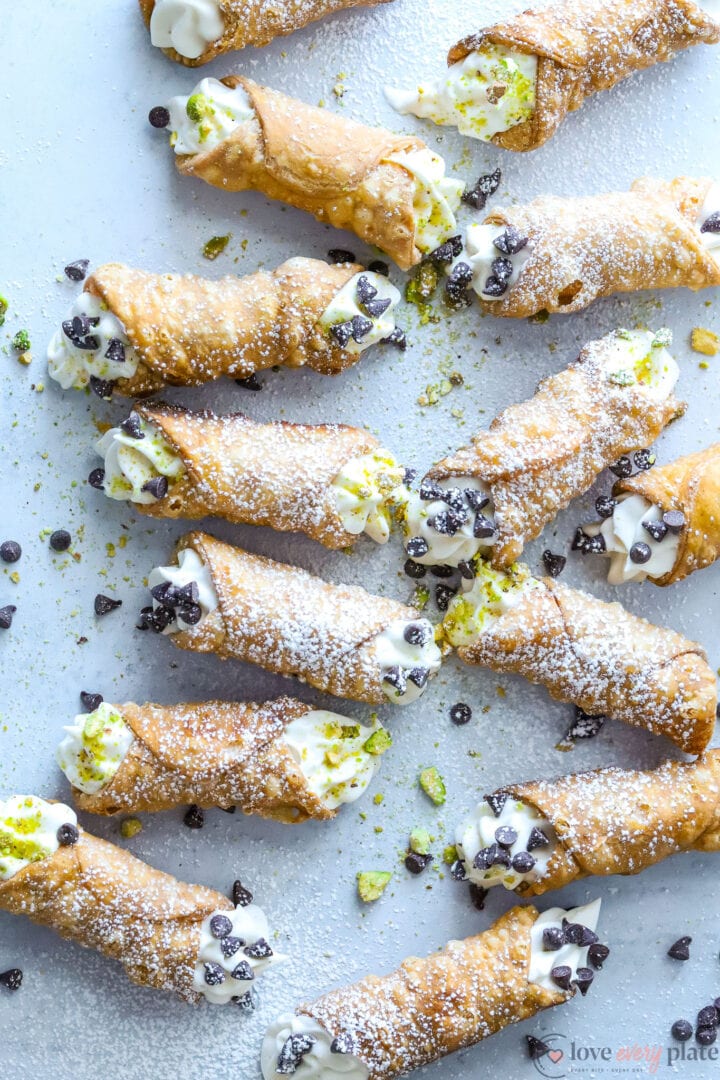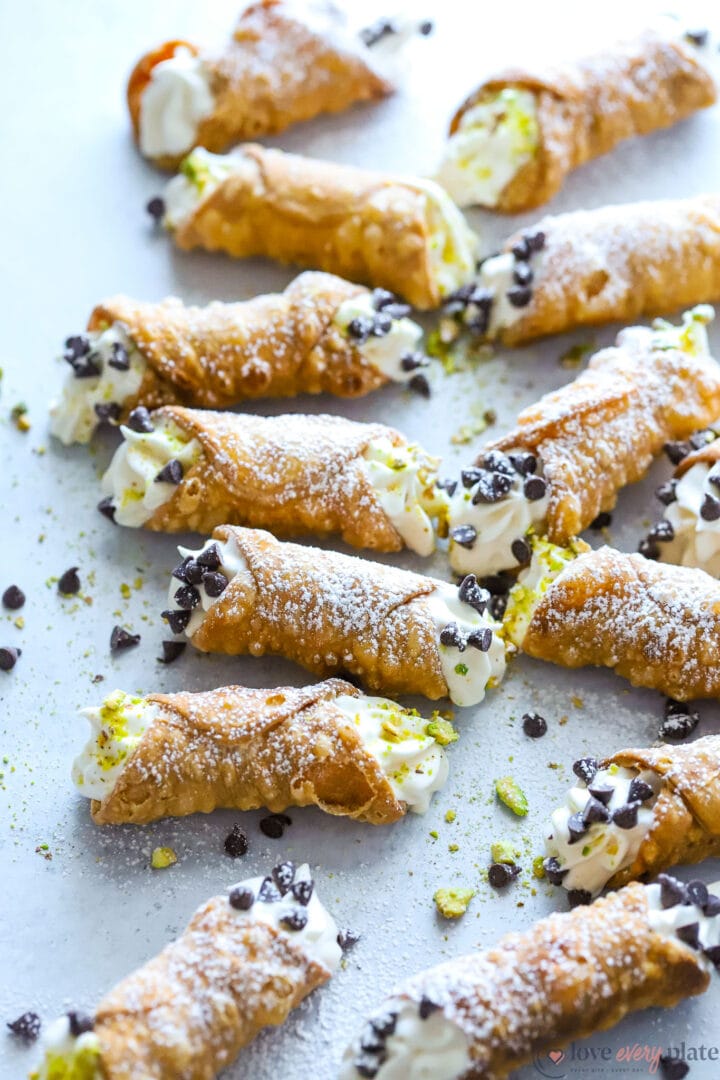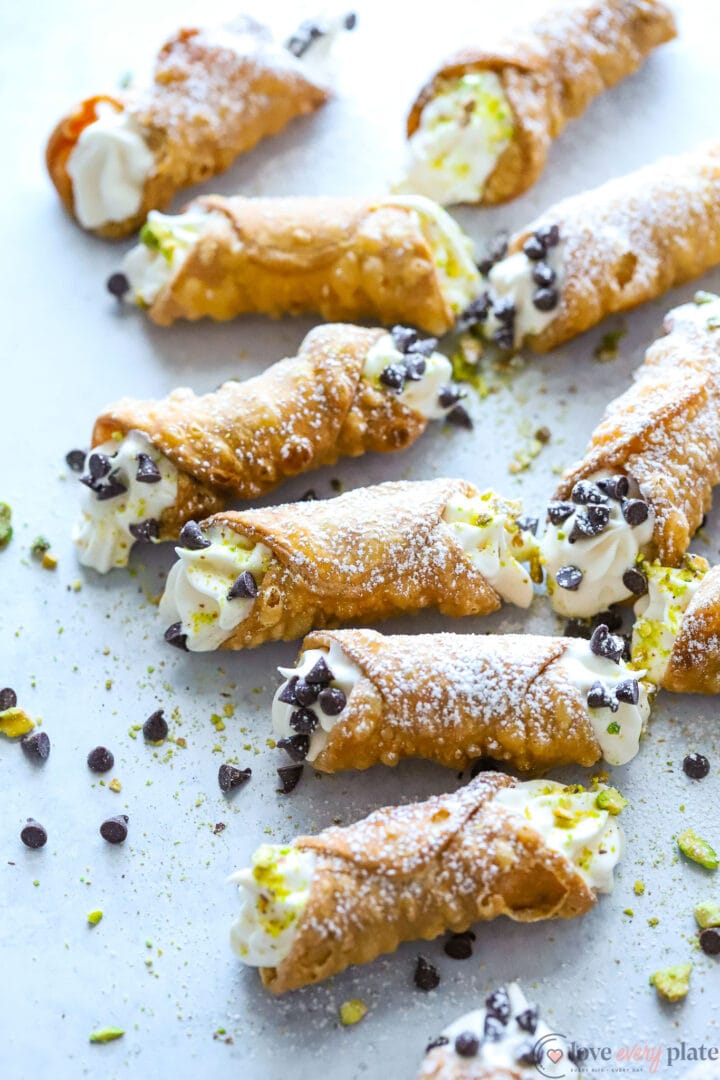Cannoli
Before I made cannoli, I had yet to find cannoli that I actually liked. So many of them either left a film in my mouth from a greasy shell, or the filling was off…something was missing. Short of flying to Italy, there wasn’t a lot of options except to make them myself.
I usually develop recipes on my own, but I had literally no idea where to begin and a serious craving to contend with. So the first thing I did was check to see if Stella had a solution for me. Of course, Miss Bravetart had made cannoli. While the shell recipe is completely hers, I adapted the filling to be a bit more light rather than rich.
Make the shells
The dough comes together quickly in a food processor, using ingredients you probably already have. When it’s time to form the cannoli shells, it’s important to roll out the dough VERY thin, to 1/8″ AT MOST. I try to get it to 1/16″, but it can get tricky.
Brush the dough with egg white, fold in half, and re roll back out to 1/8″ before cutting out your circles. Both the super thin dough and the egg white are what gives those beautifully blistered shells. As you re-roll the scraps after cutting, try not to add too much more flour, or the shells will start to get harder to roll out and more prone to falling off the form in the oil.

Frying
After reading Stella’s post, one thing was very clear: fry in a solid fat. She recommends coconut oil and she’s absolutely right. Whether you buy it at Walmart or Amazon, the price on a 56 oz jar of refined coconut oil is comparable to a jug of vegetable oil, even a little better.
The problem with frying the shells in a fat that stays liquid at room temperature, like vegetable oil, is that when the shells cool off, the fat that remains on them also stays liquid. So while the shells may have been fried perfectly and are nice and crisp when they’re still hot, they’ll inevitably get soggy/filmy at room temperature.
The coconut oil also remains on the shells, but since it cools into a solid state, it preserves the crunch on the shells and melts in your mouth rather than coating the roof of it.

Filling
The filling is lightly sweet and creamy with a little Grand Marnier to give it a boost. Don’t worry, there’s not enough for it to taste overly boozy, but definitely enough to notice the refined orange notes. It goes so well with the cinnamon and soft richness of the mascarpone.
The garnish is simple and totally optional! I prefer dunking the ends of each filled cannoli in dark chocolate shavings, and Babe prefers toasted pistachios. Heck, we even got crazy and did both on some of them. But garnish or not, these are definitely worth the extra time!
Print
Cannoli
- Prep Time: 30 minutes
- Dough Resting Time: 2 hours
- Cook Time: 30 minutes
- Total Time: 3 hours
- Yield: 30 cannoli 1x
- Category: Dessert, Pies & Pastry
- Method: Stovetop
- Cuisine: Italian
Description
Shatteringly crisp shells are filled with the most amazing light and creamy filling. Adapted from Stella Parks at Serious Eats.
Ingredients
For the shells:
- 125 grams all purpose flour
- 25 grams unsalted butter
- 1 tsp salt
- 1/8 tsp cinnamon
- 85 grams cold water from the tap
For the filling:
- 2/3 cup heavy whipping cream
- 8 oz mascarpone cheese
- 1/4 cup powdered sugar
- 1 tsp vanilla extract
- 1 tsp Grand Marnier liqueur
- 1/8 tsp salt
- 1/8 tsp cinnamon
To fry and serve:
- 42 ounces refined coconut oil
- 1 egg white, beaten
- dark chocolate shavings/shards
- toasted, finely chopped pistachios
Instructions
- Make the dough for the shells. Combine the flour, butter, salt and cinnamon in a food processor and pulse until the butter disappears and leaves fine crumbs behind. Add the water and continue to process for an additional 1-2 minutes, or until the dough becomes stringy and rides the blade. It won’t happen at first, be patient. It’s done when it looks like cobwebs. Transfer the dough to a greased bowl and tightly cover with plastic wrap. Allow it to rest for 2 hours at room temperature.
- Make the filling. In a chilled bowl, whip the heavy cream until very stiff peaks form and set aside. In a separate bowl, combine the mascarpone cheese, powdered sugar, vanilla extract, Grand Marnier, salt and cinnamon. Beat until combined and smooth.
- Fold the whipped cream into the mascarpone mixture until well blended and smooth. Refrigerate until needed.
- Form the shells and fry. Add the coconut oil to a large dutch oven or pot, and bring to 360F over medium heat. While the oil comes up to temperature, generously flour your work surface and turn out the dough. Add more flour to the top to keep it from sticking to the rolling pin, and roll out the dough no thicker than 1/8 inch. It has to be very thin, or the shells won’t fry properly.
- Dust off the excess flour, and brush the entire surface of the dough with the beaten egg white. Do not discard the remaining egg white. Fold the dough over once, and roll it back out to 1/8 inch thick again.
- Use a 3 1/2 inch round cutter to cut the dough into circles. Re roll the scraps and continue cutting circles until no more dough remains, adding as LITTLE flour as necessary. At this point, the oil should be nearly ready.
- Carefully wrap each dough circle around a cannoli form, using gentle tension to make sure the dough is snugly wrapped around the form. Use a dab of egg white to seal where the ends meet, press down gently to make sure the seal holds.
- Add the shells to the oil and fry until blistered and light golden, about 2 minutes. Use tongs or kitchen tweezers to remove the shells from the oil, and tap the tapered end of the cannoli form on the counter to release the finished shell. Repeat steps 7-8 for the remaining shells.
- Allow the shells to cool slightly or completely before filling.
- Fill and garnish. Fit a pastry bag with a 1 inch round tip and add the filling. Carefully fill both sides of each shell and dip the ends in either chocolate or pistachios. Serve immediately. Filled cannoli will only keep for a few days in the refrigerator. Do not store at room temperature.
Nutrition
- Serving Size: 1 filled cannoli
- Calories: 150
- Sugar: 4.8 g
- Sodium: 121.1 mg
- Fat: 11 g
- Saturated Fat: 8.3 g
- Trans Fat: 0 g
- Carbohydrates: 9.3 g
- Fiber: 0.1 g
- Protein: 3.3 g
- Cholesterol: 23.9 mg
Recommended for this recipe:
 Buy Now →
Buy Now →  Buy Now →
Buy Now →  Buy Now →
Buy Now → 



